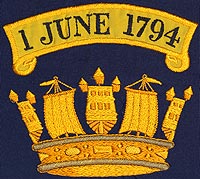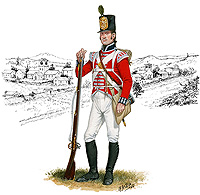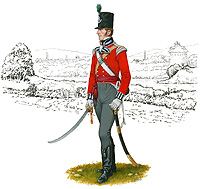 The Wars Against France, 1793-1815
The Wars Against France, 1793-1815
Glorious First of June, Egypt, Peninsular War
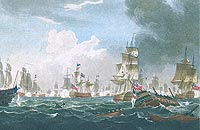 |
|
| Lord Howe's Victory. (Click to enlarge) |
|
The Glorious First of June 1794
When war was declared by the French in February 1793, The Queen’s were first stationed at Dover, where amongst their duties was that of guarding the French prisoners whose inscriptions scratched on the Castle walls may be seen today. However, in the summer the Regiment was split up into detachments to serve as marines in the Fleet. In 1794 in the main Battle Fleet under Admiral Lord Howe, which was stationed off Ushant, Queen’s detachments were serving in the Flagship, QUEEN CHARLOTTE and in the ROYAL GEORGE, DEFENCE, MAJESTIC and RUSSELL.
On 16th May the French Fleet slipped out of Brest but because of fog and mist it was not until 1st June that Lord Howe was able to engage with his whole Fleet. Then, in two and a half hours, the British Fleet broke the French line and by superior naval gunnery virtually destroyed the French, capturing 7 ships and inflicting over 3000 casualties. on the British side amongst the casualties sustained by the Regiment was Lieutenant John Neville in the QUEEN CHARLOTTE.
|
(Click images to view enlarged) |
News of the great victory caused rejoicing in England where an invasion by the French had been a perpetual source of anxiety, and King George III in person came down to Portsmouth to welcome Lord Howe and the Fleet. Following this the title “Glorious” was attached to the “1st of June” in describing the Battle, while ever since The Queen’s has maintained a special relationship with the Royal Navy, which parallels that of The East Surrey Regiment with the Royal Marines.
The Continuing War
In February 1795, having been relieved of duty at sea, The Queen’s under the command of Lord Dalhousie, were sent to the West Indies but the main enemy there was disease. By the end of 1795 the strength of the Regiment had fallen to 162 effectives, and the 2nd Battalion of the Regiment which had been formed at Portsmouth in April 1795 and sent to Guernsey, was ordered to join the 1st Battalion in the West Indies. In 1796 both battalions together took part in the capture of Trinidad from the Spanish who were the Allies of the French. Disease continued to reduce strengths, and in July 1797 both battalions were ordered home having between them only 70 fit officers and men out of the 1032 who had left England two years before.
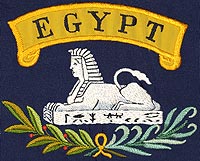 |
|
| Egypt Battle Honour (Click to enlarge) |
|
Once home the Regiment reformed, and in 1798 took part in putting down the great Irish Rebellion of that year. Then the following year they were in the disastrous Helder Campaign, where the British force defeated the French but was defeated by the inadequacies of its supply system and had to withdraw. However their Brigade Commander, Major General Sir Eyre Coote, wrote of The Queen’s that they “ upheld the honour of their country and by their skill, and the attention of their officers, advanced the glory of England against the best organised troops in Europe”.
The next campaign of the Regiment was in Egypt in 1801 where the French Army abandoned by Napoleon was defeated after an opposed landing at Aboukir Bay. Alexandria and Cairo were then captured and the French driven out of Egypt.
From Egypt, The Queen’s returned to Gibraltar where they lost over 90 officers and men in the fever epidemic of 1804. Stationed at Winchester in 1806, they received new Colours which bore the Battle Honour ‘Egypt’ and the distinction of the Sphinx.
The Queen’s in the Peninsular War
In July 1808 the Regiment joined the Army of Sir Arthur Wellesley, later the Duke of Wellington, in Portugal. Queensmen remained in the Peninsula until the final victory at Toulouse in 1814, taking part in the great battles of Vimiera, the Retreat to Corunna, Talavera, Salamanca, Vittoria and the Nivelle River. The crossing of the Pyrenees involved ten major actions in nine days of continuous movement, and in his despatch to the Duke of York, Commander in Chief of the British Army, Wellington describing The Queen’s wrote “it is impossible for troops to behave better”.
|
Vimiera, 1808, private, |
|
Vittoria, 1813, officer, |
Campaigns in India and South Africa
With peace restored, in 1816 The Queen’s returned to the West Indies, and within three months 200 officers and men and half the women and children had died of dysentery and yellow fever. They spent five years in the Caribbean, returned to Ireland for two years, and in 1825 sailed for India where they fought in the Afghanistan Campaign of 1839, subsequently being awarded the Battle Honours of ‘Afghanistan’, ‘Ghuznee’ and ‘Khelat’. After five more years in England and Ireland the next overseas station was South Africa where they were engaged in the long series of Frontier Wars that had begun in 1799. In February 1852, a year after the Regiment had arrived in South Africa, there were very few survivors of a draft of one corporal and 50 men under command of Lt Boylan, when the troopship BIRKENHEAD struck a rock and sank 50 miles West of Simon’s Bay. The account of the perfect calm and discipline of the troops on board the sinking ship, written by a survivor, was ordered by the King of Prussia to be read out as an example to every regiment of his Army.
Formation of the 2nd Battalion
During the absence of the 1st Battalion in South Africa, the 2nd Battalion was raised again at Colchester in August 1857, and two years later went first to Malta and then to Corfu, where it received its Colours, and celebrated the bicentenary of the Regiment in 1861. It remained in the Mediterranean until 1862.
From 1862 to 1865 the 2nd Battalion was in Gibraltar and the West Indies - 111 men dying of yellow fever in Bermuda - and after tours of duty in Aldershot, Ireland and Malta, arrived in India in 1878. In 1886 this Battalion won an unequalled reputation for efficiency and discipline in the Burma War, gaining another Battle Honour. They returned to England, after another stay in India, in 1894.
Related

